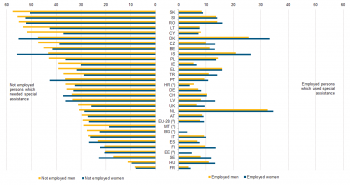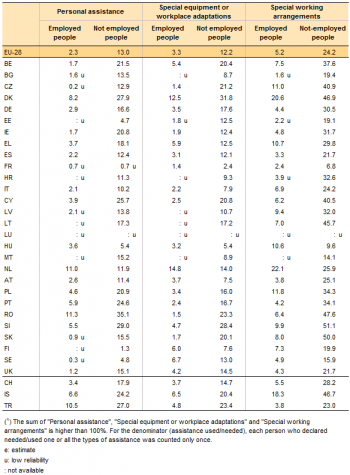Archive:Disability statistics - need for assistance
- Data from Month YYYY. Most recent data: Further Eurostat information, Main tables and Database. Planned article update: (dd) Month YYYY(, hh:00).
This article provides information on the special assistance that people having a longstanding health problem or an activity difficulty (LHPAD) use or would need in order to work. It is based on the data from the 2011 ad-hoc module of the EU Labour Force Survey and covers 31 countries (the EU-28 Member States, Turkey, Iceland and Switzerland). It is part of the set of articles on Disability.
Main statistical findings
In the Netherlands, 33 % of employed people with LHPAD have used some kind of assistance in order to work, compared with around 9 % in the EU as a whole
8.5 % of employed people in the EU who had a longstanding health problem or an activity difficulty reported that they used some kind of assistance. The country with the lowest figure was France with 4 %, while the country with the highest figure was the Netherlands with 33 %. The figures suggest that countries like the Netherlands, Denmark and Iceland are doing more to help people with LHPAD to work.

28 % of people not in work in the EU who had a longstanding health problem or difficulty in a basic activity said that they would need some form of assistance in order to work. France had the lowest figure with 8 %, whereas in Iceland, Denmark, Romania, Slovakia and Slovenia the figure was more than 50 %. France was also the only country where the figure was below 10 %.

More men than women would need special assistance to be able to work
9 % of women in work in the EU who had a longstanding health problem or a basic activity difficulty said that they had used some kind of assistance at work. For men, the figure was 8 %. More women than men used special assistance in all countries apart from Switzerland, Croatia, Greece, Poland and Cyprus. Denmark had the biggest gap between working men and women using special assistance, with 26 % for men and 33 % for women.
As for people not in work, fewer women than men said they would need special assistance to be able to work. The figures in the EU as a whole and in most countries were 27 % for women and 29 % for men. The biggest difference was in Cyprus, where one in every two men would need special assistance, compared with 37 % of women. At the other end of the spectrum, the figures for Iceland were 56 % for women and 43 % for men.

5 % of the employed people who had a longstanding health problem or a basic activity difficulty used special working arrangements
The number of people who said they needed each type of assistance far exceeded those who had actually used it:
- Personal assistance - 2.3 % of the employed people have used this, while 13 % of people not in work said they would need such help to be able to work.
- Special equipment - 3.3 % of employed people have used special equipment or workplace adaptations, compared with the 12 % not in work who said they need them
- Special working arrangements - 5.2 % of employed people used a special working arrangement, compared with 24 % of people not in work.
Sedentary jobs and teleworking were the most widely reported special working arrangements in all but 4 countries: Portugal, Romania and Turkey, where personal assistance was more widely used, and Sweden, where 7 % preferred special equipment adaptations. In the Netherlands, special working arrangements were used by close to 22 %, while in Denmark the figure was 21 %. Also, special equipment was most frequently used in the Netherlands (15 %) and Denmark (13 %). The countries with the highest percentage of people using personal assistance were Romania, the Netherlands and Turkey (all with 11 %). Women tended to use the various types of assistance slightly more than men (the difference was less than 1 percentage point in the EU as a whole).
Nearly one quarter of people not in work who had a longstanding health problem or a basic activity difficulty need special working arrangements
People not in work who had a longstanding health problem or a basic activity difficulty most often said that in order to work they would need special working arrangements. This was the case in all countries apart from Malta and Turkey, with the figures varying from 7 % in France and 10 % in Hungary to more than 50 % in Slovenia and Slovakia. 32 % of people surveyed in Denmark and 28 % in Slovenia said that they would need special equipment. Personal assistance was mentioned by 35 % in Romania, 29 % in Slovenia, 28 % in Denmark, 27 % in Turkey and 26 % in Cyprus. A significantly larger proportion of men than women said that they would need special assistance: there was a 3.1 percentage point difference for personal assistance and 1.6 percentage points for special working arrangements.

Data sources and availability
All statistics in this article are taken from the EU Labour Force Survey. This is a quarterly, large sample survey providing results for the population living in private households in the EU, Iceland, Turkey and Switzerland.
In 2002 and 2011, the survey included an ad-hoc module on the employment situation of people with disabilities. This was designed to provide information on the labour-market situation of people with disabilities, compared to those without disabilities.
Concepts and definitions
Disability
2 main concepts relating to disabilities are used in this article:
- Longstanding health problems or diseases: a health problem that has lasted or is likely to last for at least 6 months. The main characteristic of a longstanding problem is that it is permanent and is expected to require a long period of monitoring, observation or care.
- Basic activity difficulty: an activity is defined as the performance of a task or action by an individual and thus basic activity difficulties are defined as difficulties for the respondent in performing a basic activity (such as seeing, hearing, lifting, bending, etc). The difficulty must have lasted or be expected to last for 6 months or more.
Assistance
In this article, we make a distinction between assistance needed and assistance actually used. In the 2011 ad-hoc module, people not in work were asked about the assistance they needed, while employed people were asked about what assistance they used. This artificial separation between assistance needed and used was determined by the limitation to 11 variables of the ad hoc module.
In the article, ‘assistance’ means special personal assistance as well as organisational and environmental changes that help a person to work. This kind of assistance can be seen as a way of removing barriers to participation in work for people with disabilities.
Type of assistance
The 2011 ad-hoc module looked at 3 types of assistance:
- Personal assistance: colleagues, friends or relatives who help a person to work.
- Special equipment or workplace adaptations:
- special equipment: items, devices or pieces of equipment that enable a person to work;
- workplace adaptations: physical alterations to buildings where people with disabilities work.
- Special working arrangements: all kinds of special arrangements and measures that can be thought of as supporting the work of persons with health conditions or difficulties in basic activities (e.g. sedentary work, teleworking or flexible hours).
Context
The right of people with disabilities to work on an equal basis with others is laid down in Article 27 of the UN Convention on the rights of persons with disabilities. This includes the right to the opportunity to gain a living by work freely chosen or accepted in a labour market and work environment that is open, inclusive and accessible to persons with disabilities”. The following aspects are covered:
- non-discrimination,
- protection for rights,
- access to education,
- public and private-sector employment,
- opportunities for self-employment,
- support to enable people with disabilities to work on an equal footing with others.
In recent years, a lot of European countries have introduced new policies and legislation on the employment of people with disabilities. This is borne out by the national reports on the employment of people with disabilities in European countries. We have seen new policies and laws on the following:
- the right to an interview (Poland, Denmark);
- help with adapting the workplace,
- employer incentives/subsidies,
- rights to flexible working,
- job matching,
- personal assistance at work,
- support for self-employment.
Despite these initiatives and the increased attention being given to integrating people with disabilities, a lot more remains to be done. Better information and coordination are needed.
Relatively little is known about the types of jobs held by people with disabilities and the sectors in which they are employed. This is partly due to the under-reporting of people with disabilities employed on the ordinary labour market. Such people are not always recorded as being subject to a limitation on the work they can perform or as receiving specific support.
See also
Online publications
- Disability statistics - online publication
- Health - online publication - online publication
- EU labour force survey
Articles related to disability statistics
- Disability statistics - prevalence and demographics
- Disability statistics - health
- Disability statistics - labour market access
- Disability statistics - employment patterns
- Disability statistics - barriers to employment
- Disability statistics - access to education and training
Further Eurostat information
Publications
Database
- Health (hlth), see:
- Access to labour market for disabled people (Source LFS)(hlth_dsb_lm)
Dedicated section
- Health, see:
- Disability
Methodology / Metadata
- Disability statistics background - Labour force survey - overview
- Disability statistics background - Labour force survey - comparability and accuracy
- Disability statistics background - Labour force survey - non-response analysis
- Disability statistics background - Labour force survey - proxy analysis
- Prevalence of disability (source LFS) (ESMS metadata file — hlth_dsb_prv_esms)
Other information
- Commission Regulation (EU) No 317/2010 of 16 April 2010 adopting the specifications of the 2011 ad hoc module on employment of disabled people for the labour force sample survey provided for by Council Regulation (EC) No 577/98
External links
- United Nations Convention on the Rights of Persons with Disabilities (UNCRPD)
- European Disability Strategy 2010-2020
- The International Classification of Functioning, Disability and Health (ICF)
[[Category:<Health>|Disability statistics - need for assistance or support and offer]] [[Category:<Population>|Disability statistics - need for assistance or support and offer]] [[Category:<Statistical article>|Disability statistics - need for assistance or support and offer]]